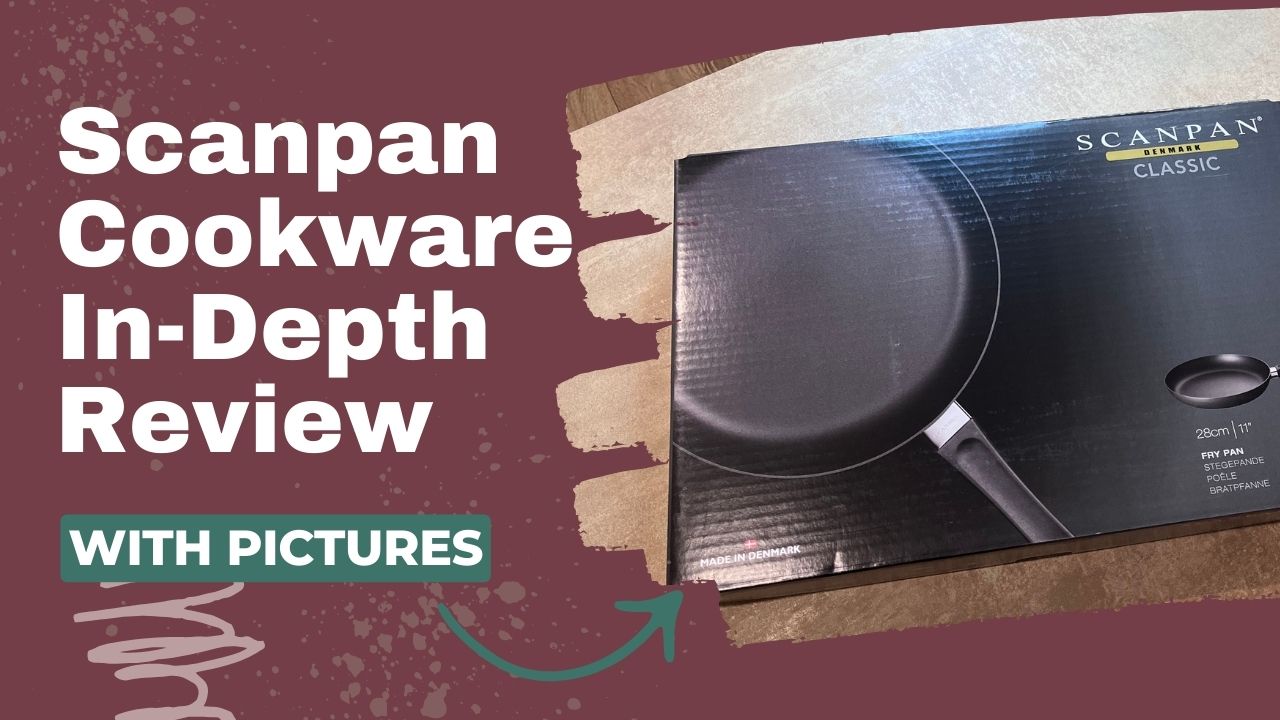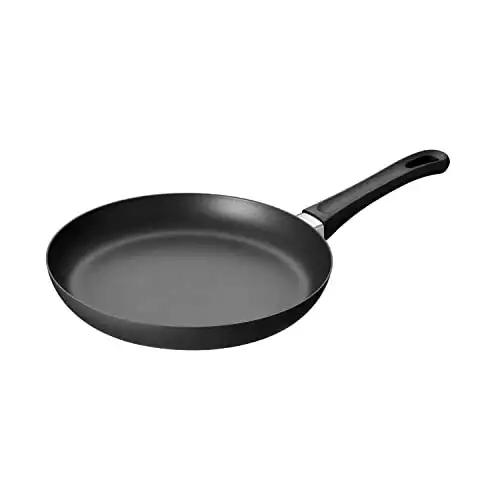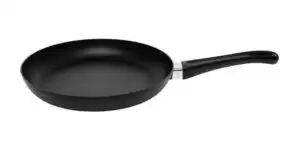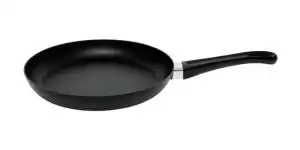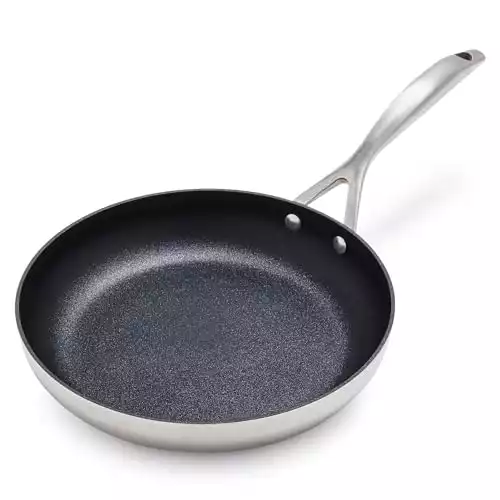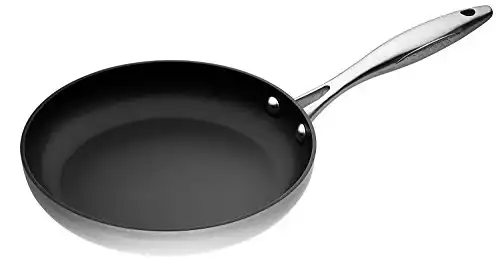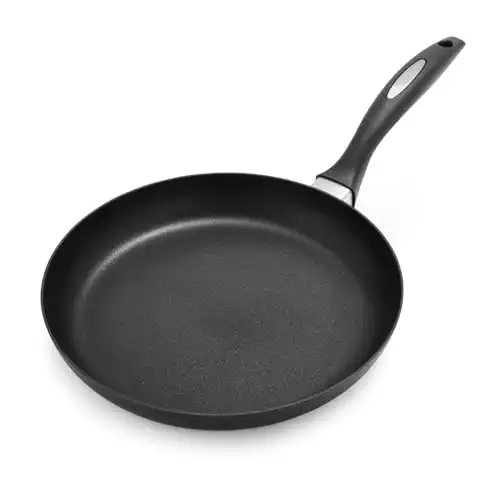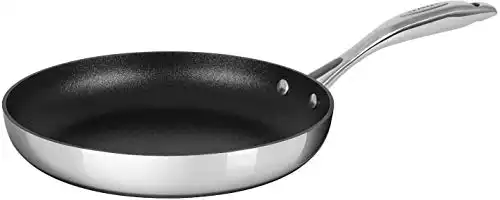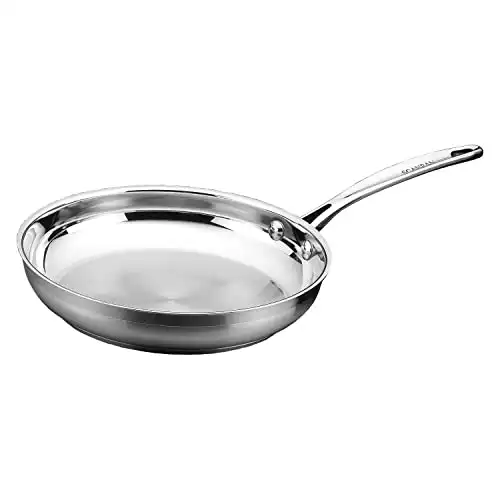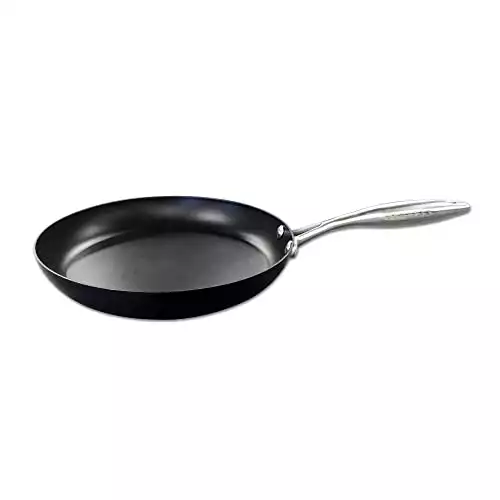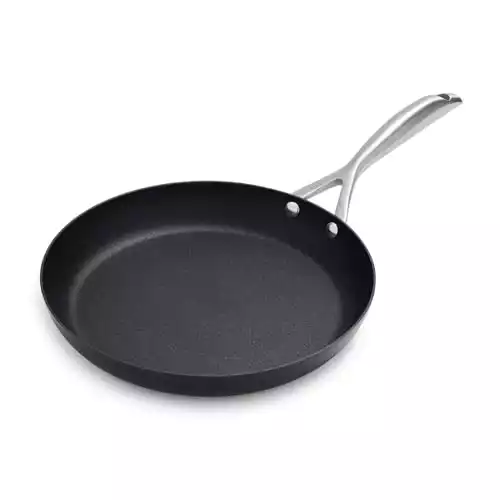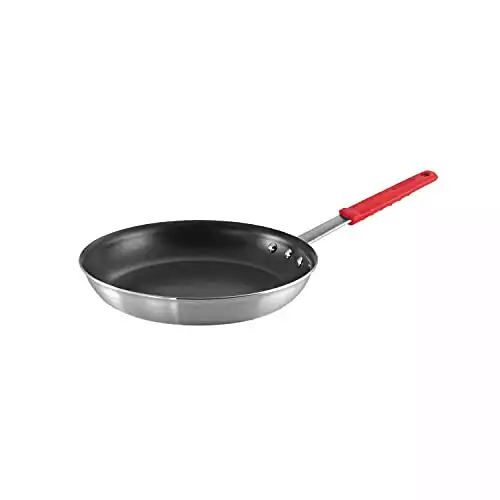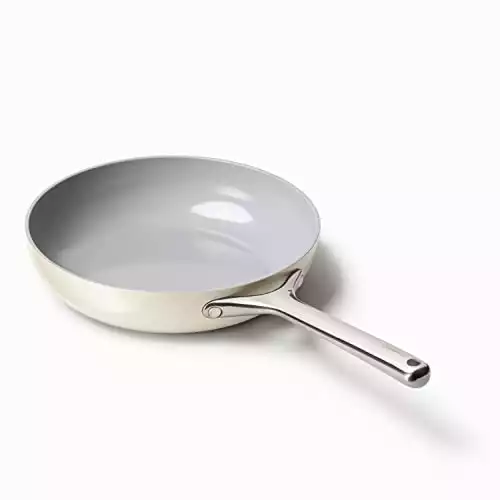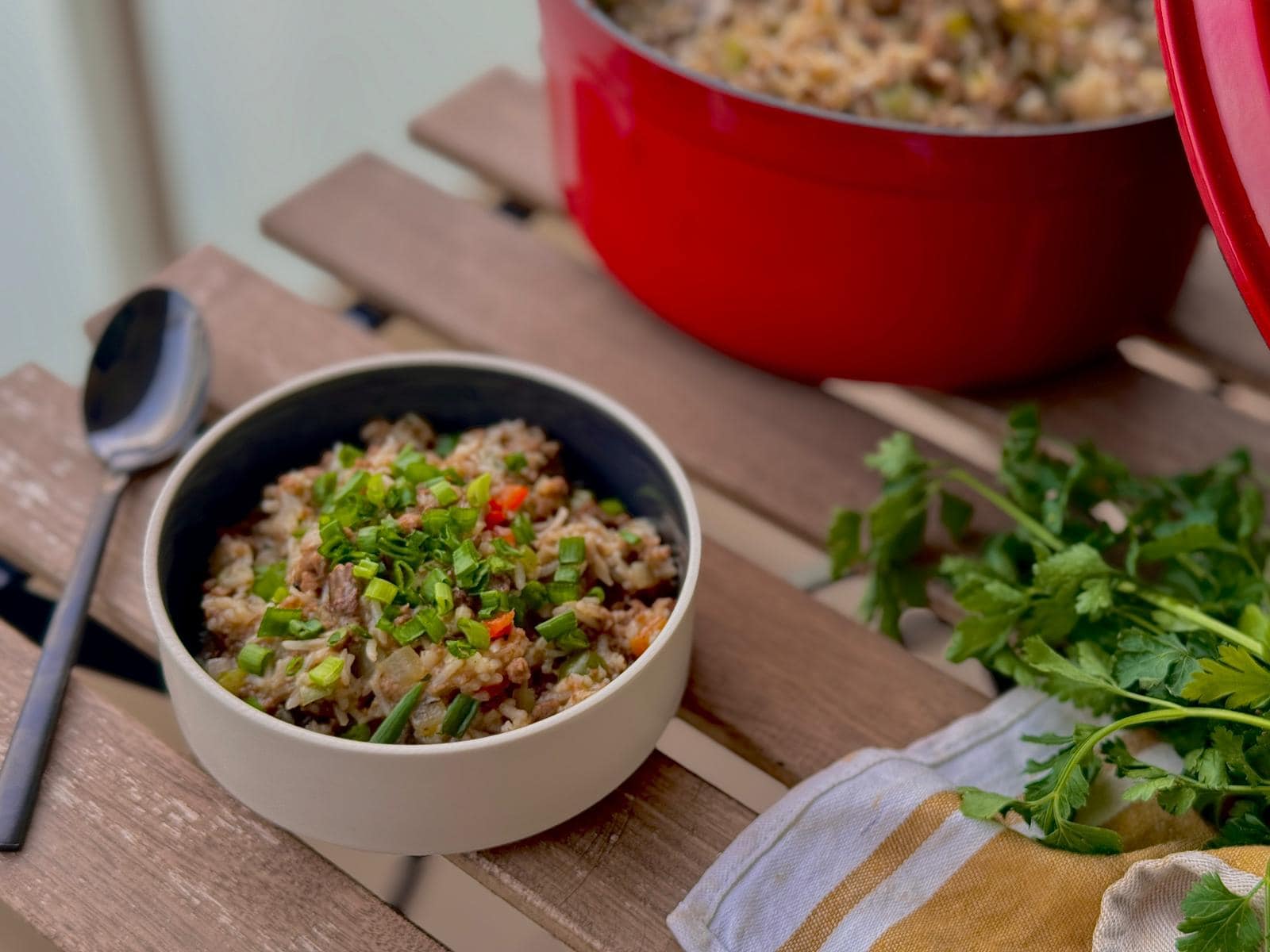Scanpan is a popular Danish brand that has been producing cookware since 1956.
In this article, we will review Scanpan’s most popular product – the Classic 11″ nonstick pan – to determine if their cookware is a good fit for you.
If you're looking for a long-lasting nonstick pan that is easy to use and maintain then this is the product for you.
Pros
Cons
With their Classic nonstick pan, Scanpan says you get a kitchen workhorse that can sear, braise, go in the oven, and handle delicate foods - and do all that with little to no oil. What’s more, they claim you can safely use the pan with metal utensils and put the pan in the dishwasher.
I bought their Classic nonstick pan and conducted extensive tests on this pan to see if Scanpan’s promises were true.
In this Scanpan Classic review, you will learn everything you need to know about this pan and if its performance justifies the higher price. We will also compare this pan with other products in Scanpan’s lineup to help you decide if it is the right fit for your kitchen.
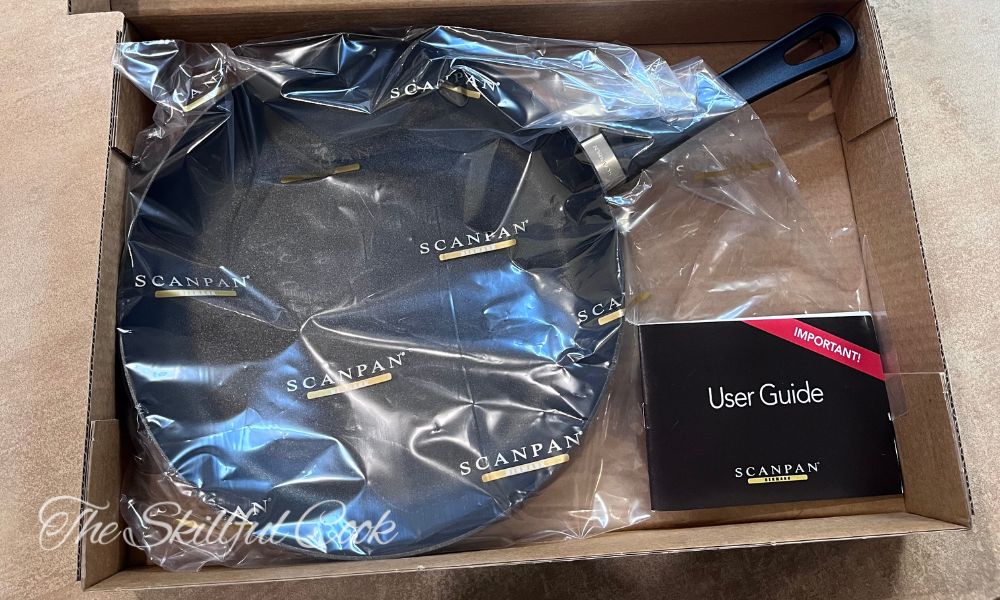
Scanpan Cookware Comparison
Scanpan offers 10 different collections of cookware. The following table compares each one of them:
Scanpan Classic Nonstick Pan Review

Quick Overview:
How I Tested The Scanpan Classic Pan
I used this pan over the span of two months to test its cooking performance. I’ve cooked many meals with this pan, including steak, eggs, French omelets, and more.
Scanpan positions its Classic nonstick pan as a premium product. Other producers of PTFE nonstick pans promise similar performance, and their products can be bought at half the price. I purchased a Tefal Day by Day pan and compared it side by side with the Scanpan Classic pan to determine if Scanpan was worth the extra cost.
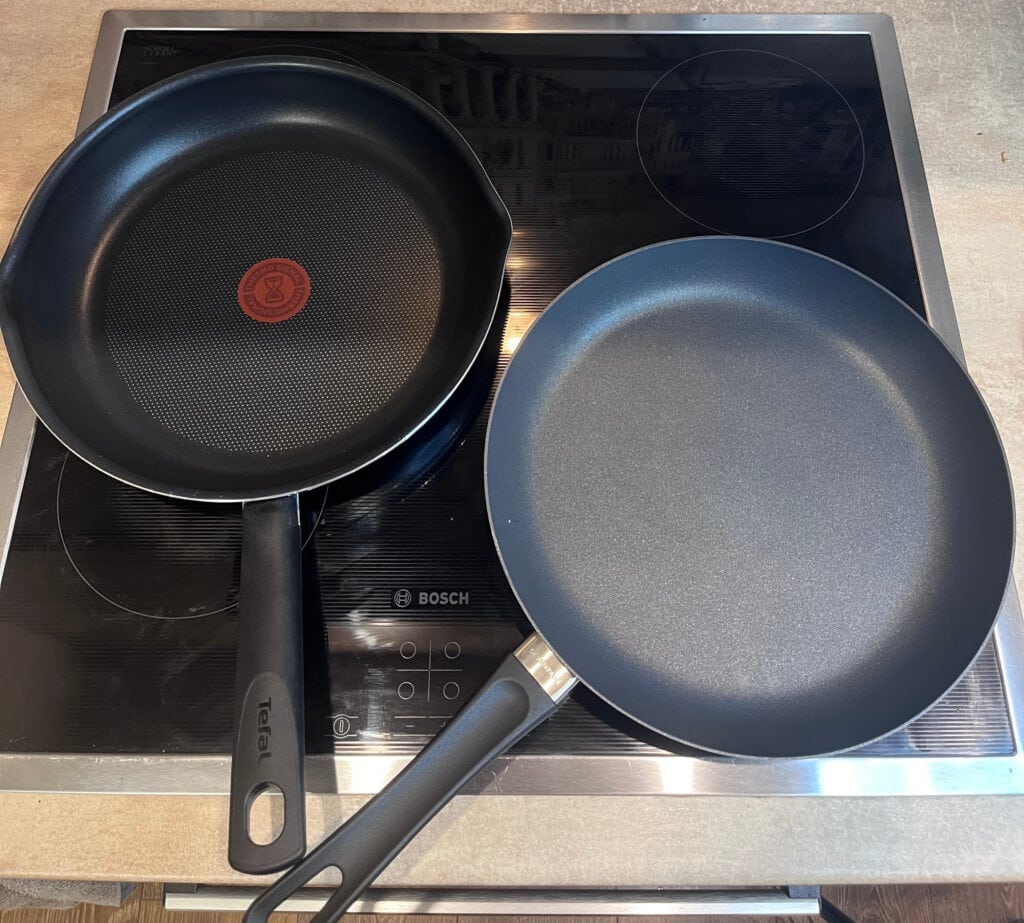
My only reason for choosing Tefal was that at the time of buying it, the Tefal Day by Day pan was on sale and almost $60 cheaper than the Scanpan Classic pan (normally, the Tefal pan is around half as expensive). I don’t have a particular preference for Tefal. Any other cheap Teflon pan would have worked just as well for this comparison.
Cooking Performance
Cooking eggs without oil
TL;DR: The Scanpan Classic pan performed as well as you'd expect from a brand-new nonstick pan. But so did the cheaper pan from Tefal. This didn’t come as a surprise because eggs are precisely the type of food that a nonstick pan is intended for.
For my first test, I preheated the pan on medium heat for a minute and cooked an egg without using any oil at all.
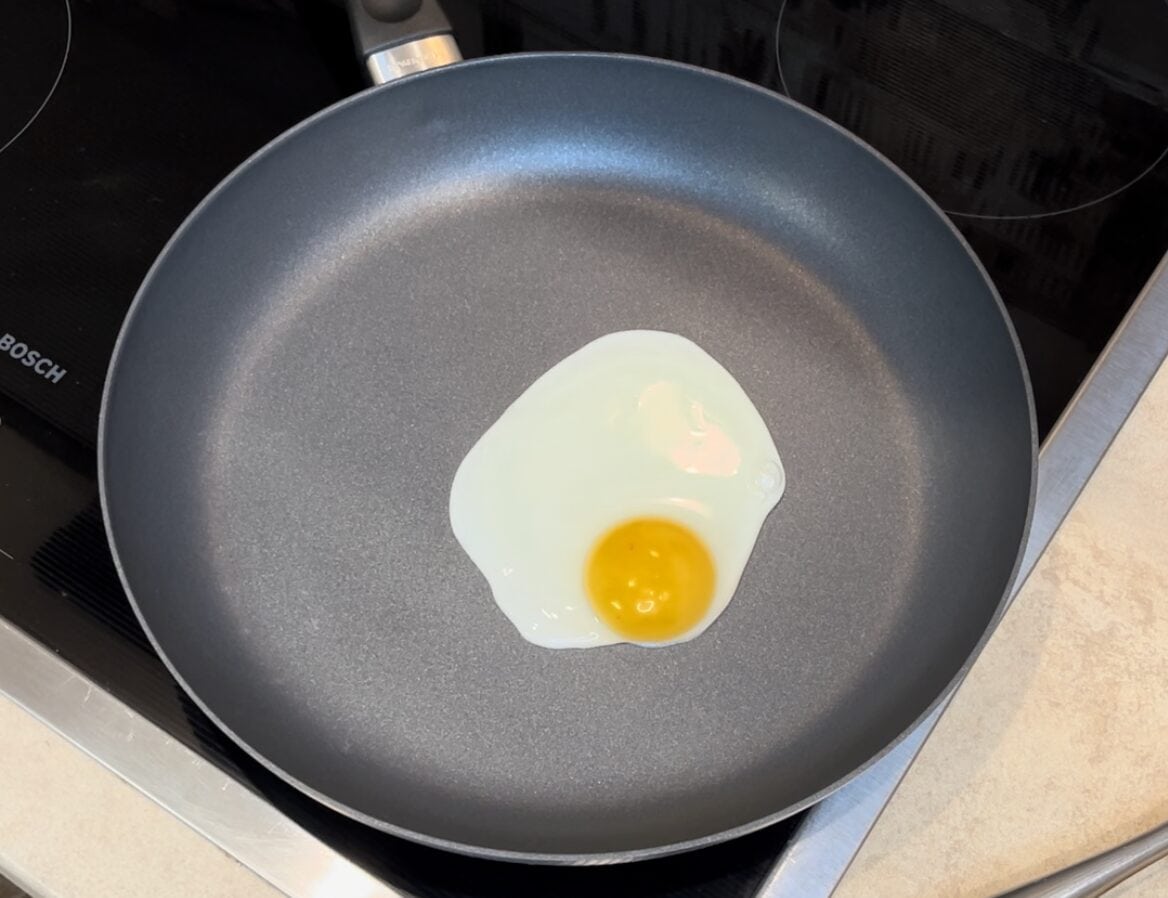
I let the egg fry for around one and a half minutes and then flipped it using a plastic spatula.
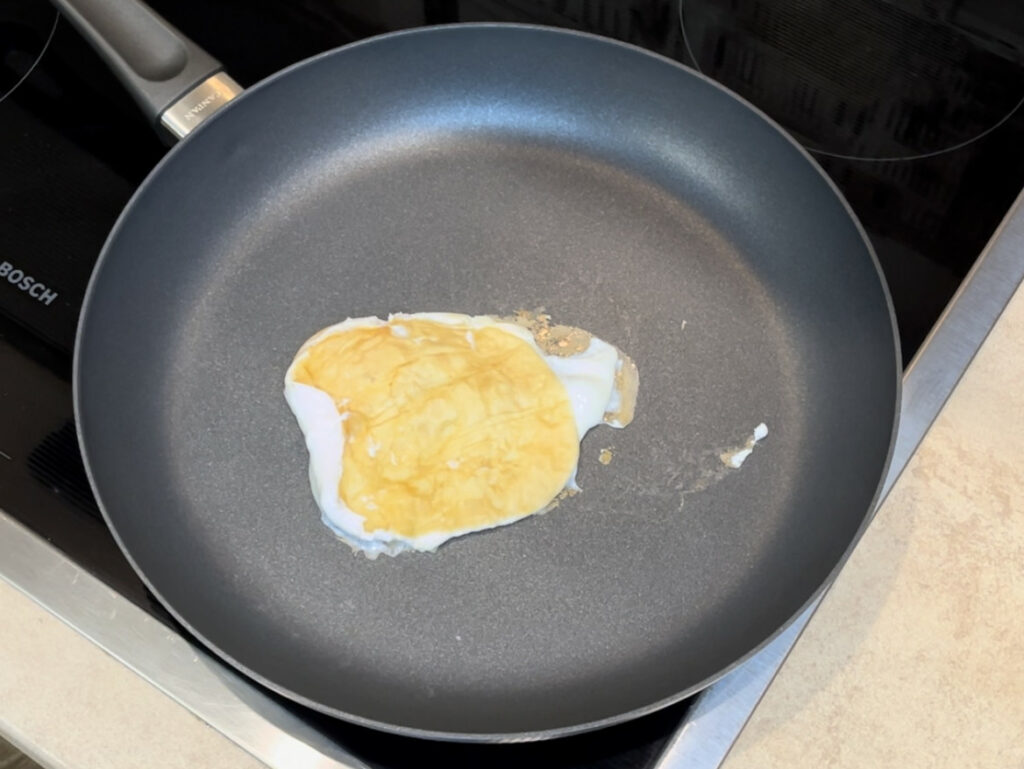
The pan released the egg without any issues. The egg did not burn or stick, proving that the pan can be used to fry delicate proteins with no oil without sticking.
I then used a metal spatula to flip the egg again to test if the metal would scratch the nonstick coating. As previously, the pan released the egg perfectly.
It felt wrong to use a metal spatula on a nonstick pan, but I found no scratches or damage. This proves that you can use metal utensils on this pan.
That said, the pan released the egg so easily that there wasn’t really a need to use a metal spatula. If you buy this pan, I suggest you only use non-metal utensils to get as much life out of the pan as possible.
I cooked another egg, making sure not to overcook it this time. As soon as the egg white solidified, the egg started sliding without me having to add oil or use a spatula.
How did the cheaper Tefal pan perform?
I followed the same steps with the Tefal Day to Day pan and found that it performed just as well. The egg did not burn or stick to the pan.
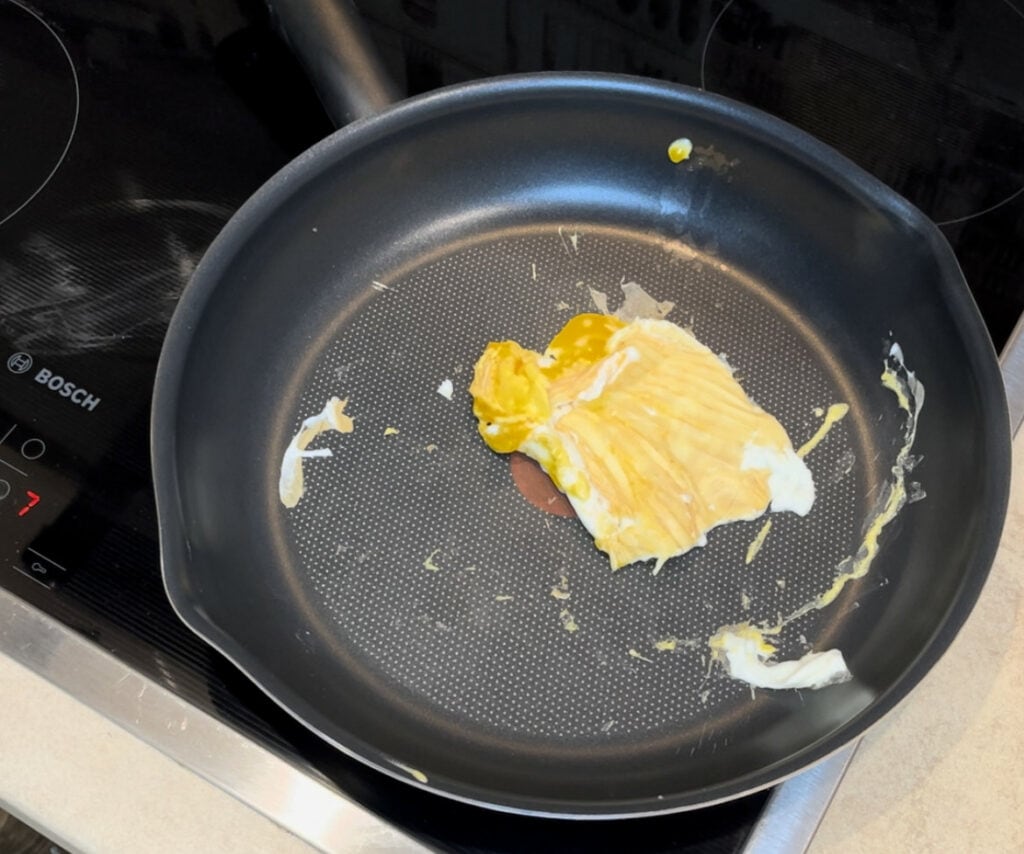
The only difference was that I didn’t use metal utensils as the Tefal pan is not explicitly advertised as metal utensil-safe.
French omelets
For my next test, I cooked French omelets in both pans. French omelet is the perfect dish for testing how nonstick a pan is, as well as how well it responds to temperature changes.
I allowed the pan to preheat on a medium heat setting for about a minute. I melted a tablespoon of butter and poured in four beaten eggs. I stirred the eggs, waited until they solidified, added some cheese, and started spreading the omelet while moving the pan in and out of the heat.
End result: soft, evenly cooked omelet that is a bit runny on the inside. The omelet test showed me that the Scanpan Classic pan heats evenly and is very responsive to temperature changes, making it a great pan for delicate dishes like French omelets.
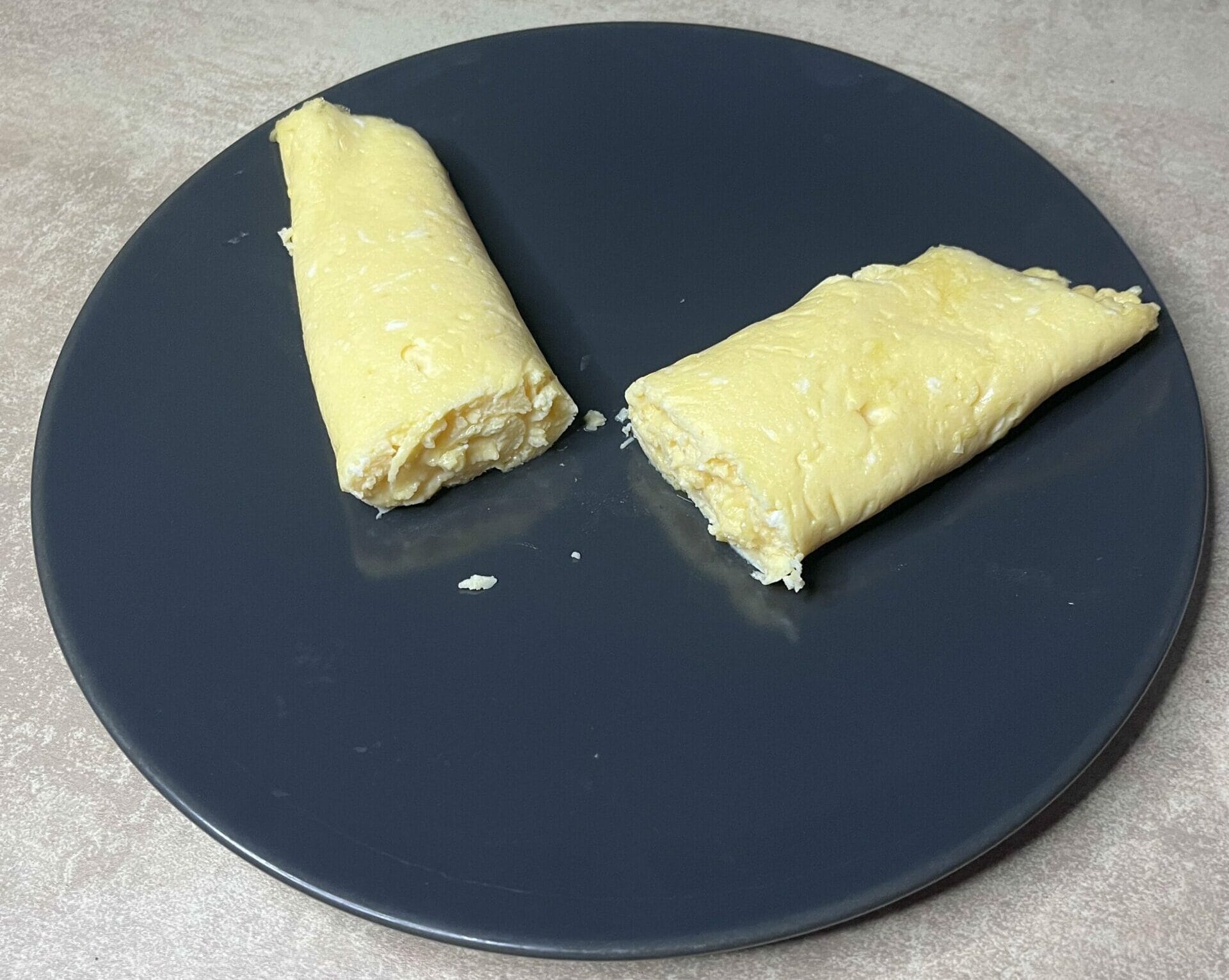
How did the cheap pan compare?
I cooked an omelet in the cheap pan and the results were also good. The cheap pan was just as nonstick and responsive to temperature changes. Perhaps even more responsive because it is made out of thinner aluminum, which also makes it lighter and easier to maneuver.
The takeaway: If you plan to use your nonstick pan solely for cooking eggs, then any low-priced nonstick skillet will suffice. However, if you want a pan with a longer lifespan and use it for cooking other food items besides eggs, buy the Scanpan Classic skillet.
Cooking steak
Scanpan advertises its nonstick pan as being capable of searing with minimal or no oil, as stated on its sales page. However, getting a good sear requires high temperature, and Scanpan cautions against overheating the pan as this can compromise its nonstick coating. This pan should only be used on medium-low or medium heat.
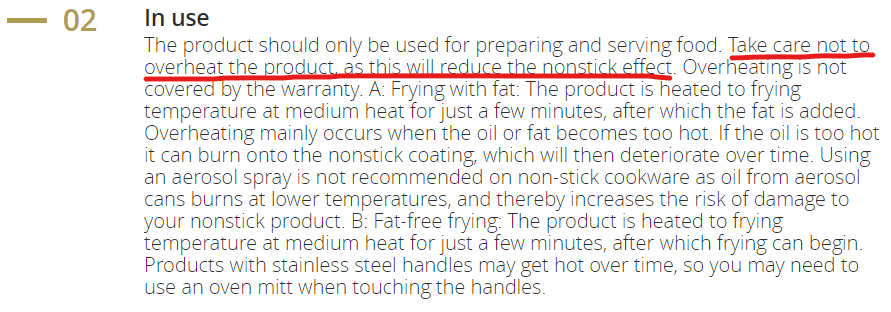
I decided to test how good of a sear the pan will produce at medium temperature.
I dried the exterior of the steak with paper towels and seasoned it. Next, I gradually preheated the pan to a temperature of 350F. I cook on an electric range, and the pan heated up evenly across the entire cooking surface without warping.
I added a tablespoon of clarified butter and cooked the steak for six minutes, flipping the steak every 30-40 seconds. End result: the pan lightly browned the steak but did not produce a crispy crust.

It took six minutes to achieve satisfactory browning of the meat. The steak achieved an internal temperature of 160 F, resulting in a well done steak. The steak I cooked weighed around 250 grams and wasn't very thick.
The takeaway: You can cook a steak on this pan, but don’t expect the result to be as good as what you can achieve with cast iron or carbon steel. As with any Teflon pan, you can only use it on medium heat at most, which limits its ability to create a good sear.
Build Quality
Scanpan cookware is manufactured in Denmark, which explains its name (Scanpan - Scandinavian Pan). The Classic pan is made from recycled aluminum, and it weighs 2.3 pounds.

It's heavier than most aluminum nonstick pans but not too heavy for smaller individuals or people with limited mobility. The pan feels sturdy, well-balanced, and not flimsy like the cheaper pan I tested alongside it.
The cooking surface and the outside edges are covered with a black PTFE-based nonstick coating that keeps the food away from contact with the aluminum base.
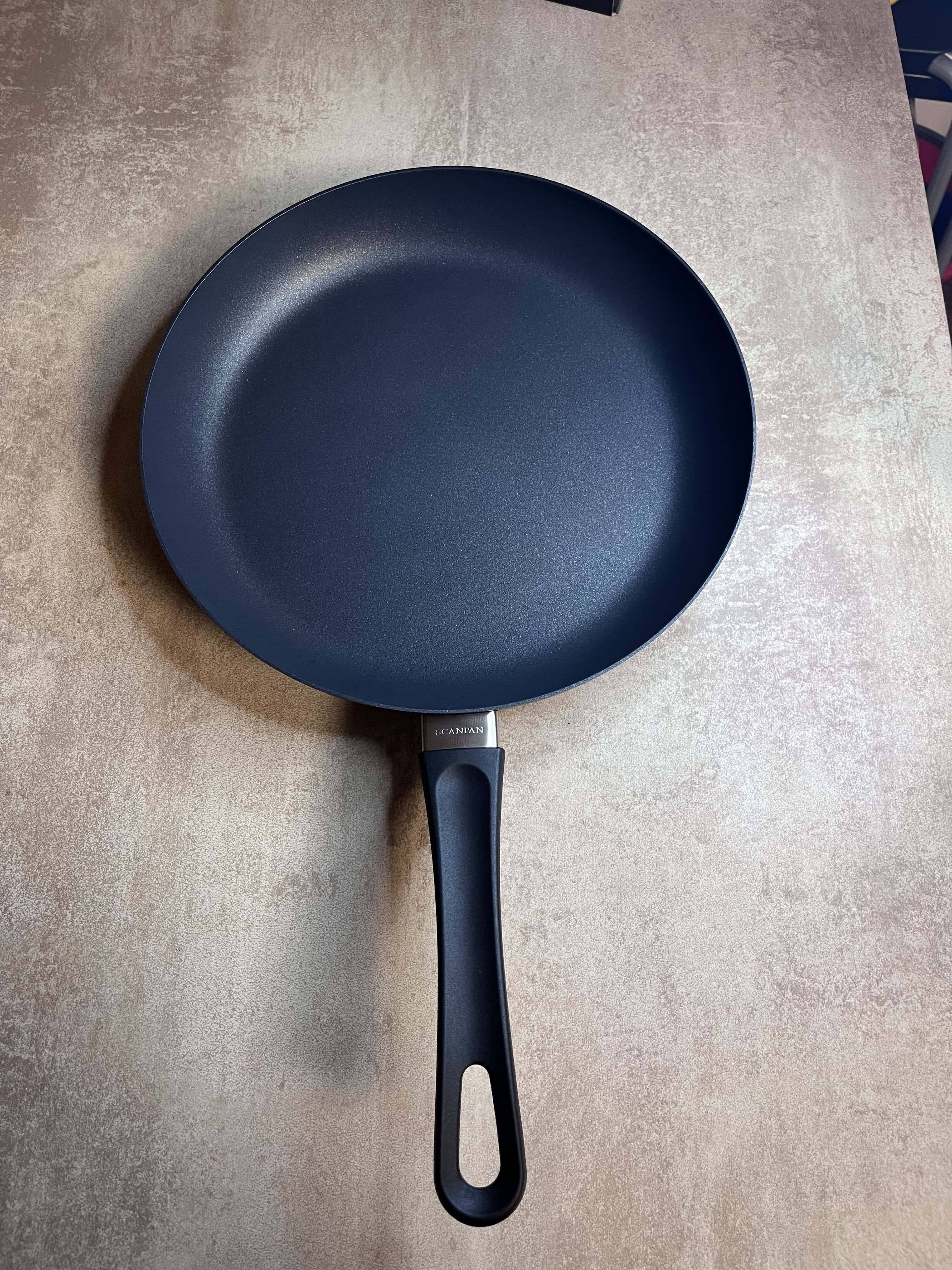
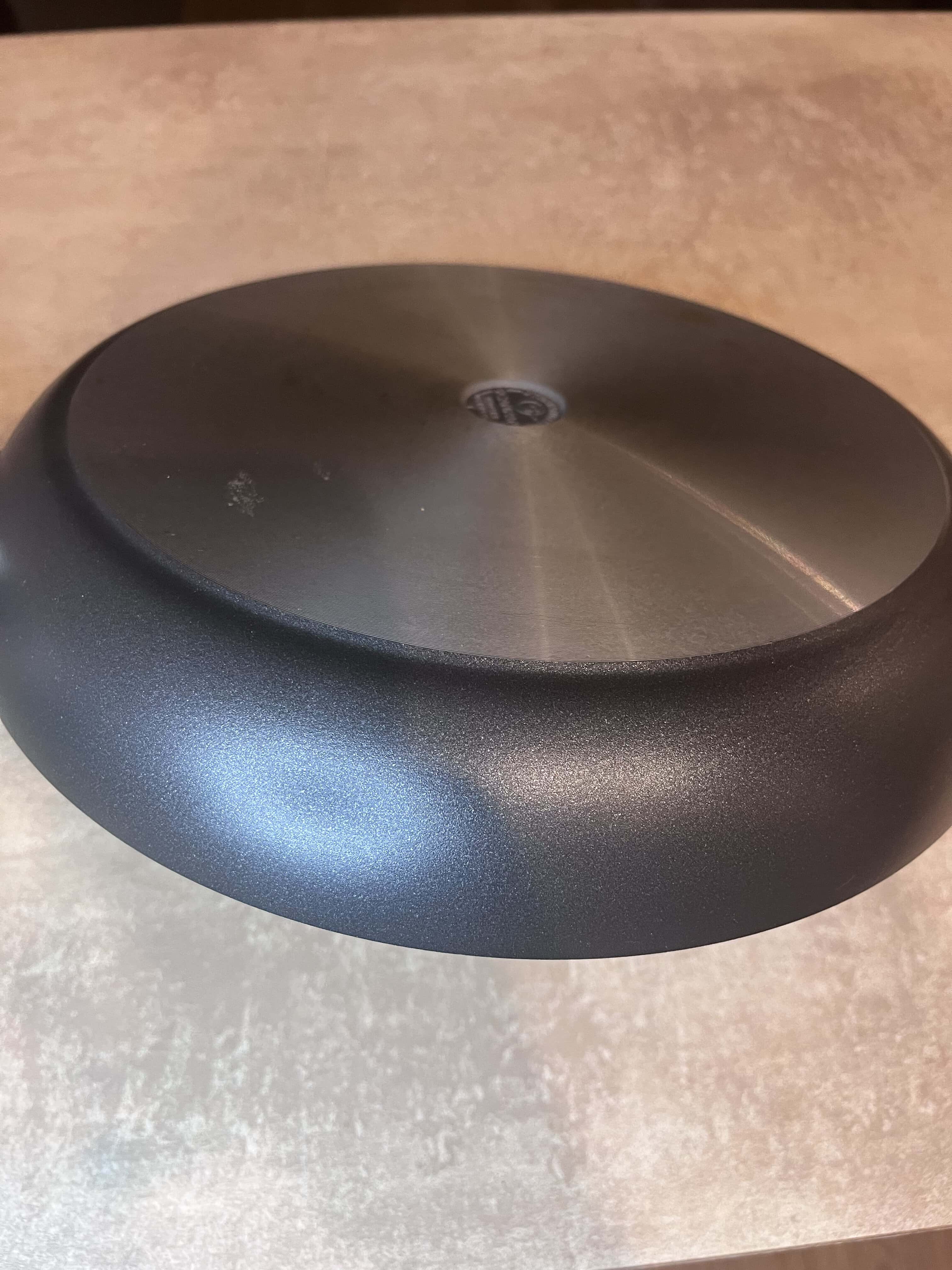
Scanpan calls their nonstick coating Stratanium, which is the standard coating they use on many of their nonstick pans, including the Classic pan. They say it’s a “unique coating” that includes “multiple layers of nonstick coating, including small and large, hard particles that interlock with thermally sprayed layers to reinforce the nonstick coating.”
In simple words, the pan uses a reinforced multilayer Teflon coating, which, as Scanpan claims, has a 30% better nonstick effect, 30% higher durability, and 30% longer lifespan.
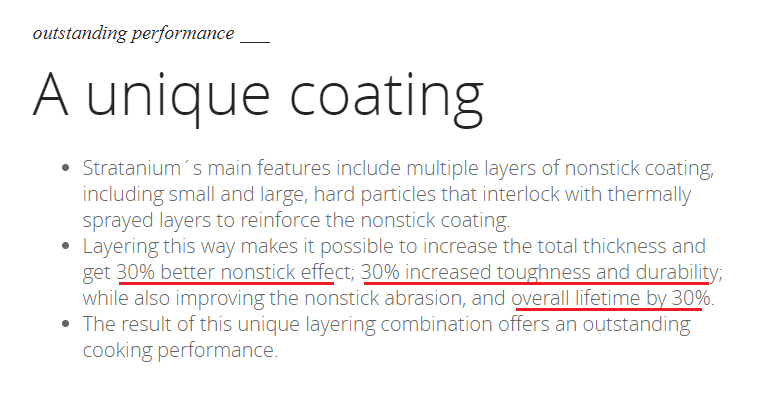
However, it is unclear what the 30% difference is being compared to exactly.
I used the pan with a metal spatula, and it did not damage the Stratanium coating, proving that the coating is resistant to light metal scratches.
The handle is made of black, oven-safe Bakelite plastic. The handle stayed cool throughout my tests, even when I cooked a steak at 350F.
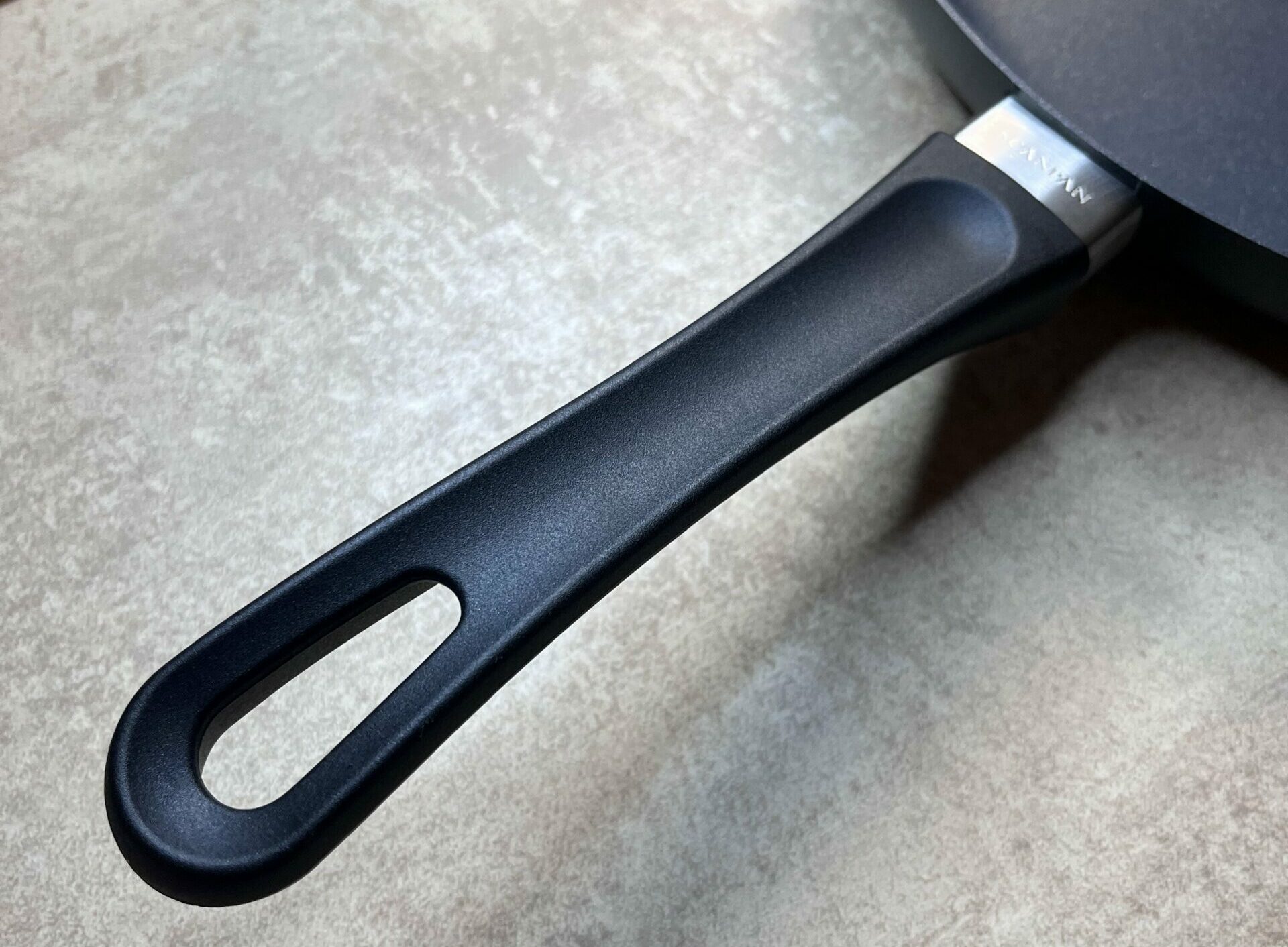
Scanpan doesn’t share the details of how they attach handles to their Classic pans. They only say that they use a patented locking system that does not require screws or rivets. Based on my experience using the pan, I can say that it felt stable and didn't wobble, even when I twisted the pan aggressively from side to side. The handle stays securely fixed in place.
Design and Comfort
The Scanpan Classic was designed with Scandinavian minimalism in mind. Unlike the Rachael Ray cookware line we tested, Scanpan cookware has just one color to choose from: dark gray. Personally, I like the look of this pan.
The nonstick coating extends to the outside edges and ends where the bare aluminum part that touches the stovetop starts.
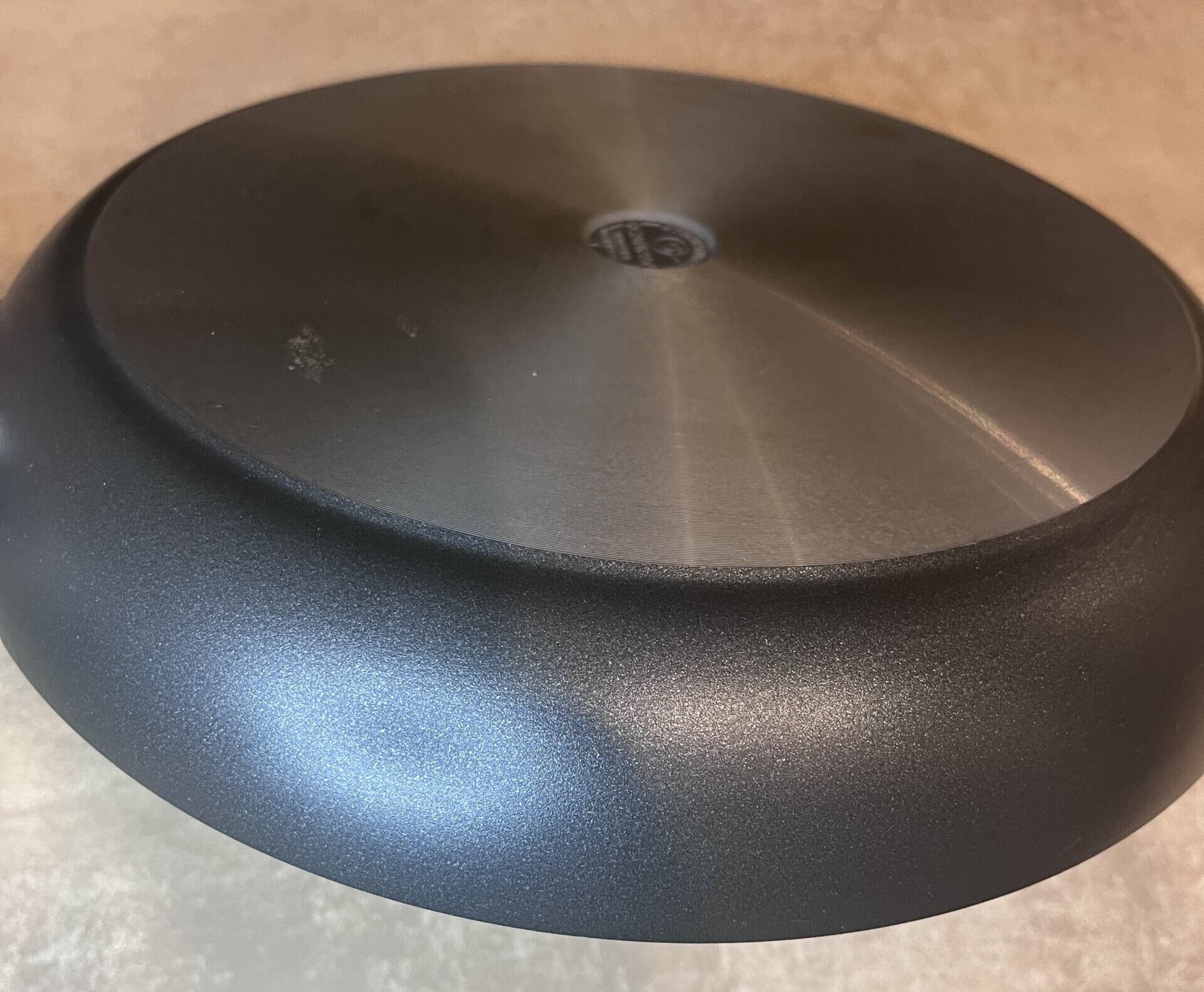
I really like how they covered the outside of the pan with a nonstick coating. I found that this makes cleaning the pan easier because streaks of liquid won’t stick on the outer part.
However, If you use a gas stove, make sure to use the right burner size so that the flame doesn’t burn the Teflon coating on the outside. Teflon can release toxic fumes if overheated.
The pan's handle is attached to the body without rivets. I like that because that prevents grease buildup around rivets and makes cleanup easier.

An aluminum flame guard serves as a barrier that prevents the handle from getting hot. This is a useful feature if you intend to keep the pan on the stove for long stretches of time.

The only downside with this is that the flame guard cannot be removed without breaking it, making it impossible to clean if grease accumulates inside.
The handle of the pan has a ridge running along its full length, which is the width of a thumb. This feature is very useful as it allows you to have better control of the pan. It is particularly helpful when you are cooking a large quantity of food and need more leverage to move the pan around. I personally prefer this handle design over rounded handles as it gives a much better grip.

Versatility
I doubt I will ever give a nonstick pan a 10/10 score for versatility because it cannot be used on high heat as it would damage the nonstick coating. However, if you don't cook at high temperatures or don't mind a less-than-perfect sear on your steak, this pan can still be a decent jack-of-all-trades.
As my cooking tests have shown, this pan is great for cooking on low to medium heat. It's perfect for preparing delicate proteins and braising. It can create an acceptable sear on medium heat, but it won't match the beautiful and crispy sear that you can get with a cast iron or carbon steel pan.
The pan I tested is not compatible with induction, but Scanpan offers more expensive options that are.
Scanpan Classic is broiler and oven-safe up to 500F, which is nice if you cook a lot of stovetop-to-oven dishes. Just don’t keep the pan for too long in the oven at high temperatures because this will cause the coating to degrade faster.
Ease of Use and Maintenance
This pan is incredibly easy to use. It doesn’t require much skill, and the non-stick coating makes the pan very forgiving. You’ll have to try hard to make anything burn and stick to this pan. It is much easier to use and maintain than stainless steel or cast iron, making it perfect for beginners.
This pan does not require seasoning. It has a good nonstick coating that does an excellent job of releasing food.
Cleaning the pan is also a breeze because any leftover bits of food just slide away from the pan. I didn’t have any issues washing it by hand. A small drop of dish soap and a sponge is all you need to clean it after cooking with oil.
If you find hand-washing too much trouble, you can put it in the dishwasher because it is dishwasher-safe. However, Scanpan cautions that harsh chemicals in some dishwasher detergents can shorten the pan’s lifespan.
I recommend hand-washing it always to prolong its lifespan.
Longevity and Warranty
On their warranty page, Scanpan states they offer a product lifetime guarantee on their pans against any material or manufacturing defects. If you receive a product that's unsatisfactory, you can return it for free repair or get a replacement. However, you will most likely have to pay for the shipping costs.
The warranty does not cover glass lids.

It's important to note that the warranty is valid for the lifetime of the product, not the lifetime of the customer. So, how long can you expect this pan to last?
As a general rule, a high-quality nonstick pan made of PTFE can last between 3 to 7 years, provided it is handled with care. After using this pan for a few weeks, I can say with certainty that Scanpan Classic is a high-end nonstick pan. Still, it is not a heirloom piece, and you will eventually have to swap it out for a new one.
Generally speaking, buyers are happy with the longevity of these pans. This buyer left a review on Amazon saying that after three years of use, his pans look almost like new.
In a more recent review, a buyer shared their experience using the Classic pan for two years. They said that the pan started to stick, but a thorough cleaning of the pan restored its nonstick properties.
Another verified buyer claims his Classic pan lasted for six years of daily use.
However, this buyer criticized the pan, saying that the pan lost its nonstick abilities after 18 months of use. Another buyer shares that their pan lost its nonstick properties after a couple of months of regular use. Unfortunately, it is impossible to verify whether these buyers used their pans with proper care.
In terms of longevity, I'm giving this pan a 5 out of 10 rating, as we reserve the maximum score for products that can last a lifetime.
Price and Availability
Scanpan Classic pans are one of the pricier options when it comes to high-end nonstick cookware.
Although it is still comparatively cheaper than an 11-inch Swiss Diamond pan (non-induction and includes a lid), the price of a single 12.25-inch induction Scanpan Classic pan (no lid) is similar to the price of two induction-compatible All-Clad nonstick pans.
The pan is available in a round or square shape (grill pan), with or without a lid. Available sizes range from 8” to 14”. The pan is also available in induction variants.
Scanpan products are available for purchase through various retailers such as Amazon, Williams Sonoma, Macy's, Walmart, and Sur La Table, as well as directly from the Scanpan website.
Safety and Health Considerations
Scanpan's Stratanium nonstick coating is made from PTFE, colloquially known as Teflon. The consensus is that PTFE coatings are safe and do not cause harm if ingested. However, more studies are needed to confirm this.
We know that overheating the pan to 570 F (300 C) can cause Teflon to break down and release toxic fumes, which can cause a condition called polymer fume fever. For this reason, you should only use the pan on low to medium heat.
Scanpan’s products are manufactured in Denmark, which means they must comply with European cookware safety regulations. European regulations are stricter and more comprehensive than American regulations.
Scanpan has a disclosure that shows a list of potentially harmful ingredients they use in their cookware. You can read the full disclosure here.
Bottom line: The fact that Scanpan has to adhere to EU cookware regulations gives us confidence that their products are safe. However, there is some controversy regarding the safety of PTFE and other "forever chemicals" belonging to the PFAS family.
In terms of health and safety, we only give the highest rating to products that use ingredients whose safety has been proven. For this reason, Scanpan Classic gets a score of 7 out of 10.
Company and Environmental Impact
Scanpan claims that it’s been in business since 1956. As shown in its official company records, the company was initially registered under the name PYROLUX PANDEFABRIK ApS in 1977. It wasn't until 2002 that the company's name was changed to Scanpan A/S. Since then, the company's name has remained unchanged.
To our knowledge, Scanpan has never been involved in any scandals or lawsuits, and none of its products have ever been recalled.
Scanpan highlights its commitment to sustainability. They use recycled aluminum in their manufacturing process and maintain high environmental standards. Scanpan plans to fulfill 87% of its energy needs through renewable sources. Only 9% of its waste ends up in landfills.
Scanpan claims to pay their employees fair wages. Scanpan's headquarters and production plants are located in Denmark, which is known for its strong labor laws.
Scanpan products are durable and high quality. You will not have to replace its pans as often as cheaper nonstick pans.
Scanpan has stopped using PFOA and PFOS - chemicals that are proven carcinogens, but their nonstick products still contain PTFE.
Scanpan argues that PTFE is safely bound in the coating and does not pose any risk to people or the environment. However, more studies are required to ascertain the actual environmental impact of PTFE. According to the CDC, PFAS, a group of chemicals that PTFE is part of, does not break down in the environment and can contaminate drinking sources, bioaccumulating fish and wildlife.
What Do People Say About Scanpan Products?
Online reviews of Scanpan's products are generally positive.
On Amazon, customers who have bought the Scanpan Classic pan have reported that it heats up evenly and retains heat well for an aluminum nonstick pan. Additionally, it is easy to clean and, if properly taken care of, can last for five years or more. Some customers have reported issues with the nonstick coating, but they rarely elaborate on whether the pan was used as intended.
Epicurious featured the Scanpan Classic pan in their article about the best nonstick pans. Testers were pleased with its nonstick surface.
Food & Wine named Scanpan a “strong contender” in their review of nonstick pans. However, the reviewers believe its higher price makes it less desirable in comparison with more affordable brands.
Alternatives to Consider
If you're in the market for a nonstick pan, but uncertain if you want a Scanpan product, these are some good alternatives.
Frequently Asked Questions
Is Scanpan High Quality?
After using this pan for a few months, I can say that Scanpan is indeed high quality. The construction is solid. It heats up evenly and maintains heat well for an aluminum nonstick pan. Its durability sets it apart from many other nonstick pans on the market.
Is Scanpan Made in China?
Scanpan produces all of its nonstick products in Denmark. However, their stainless steel cookware collections, such as Impact and Fusion, are made in China.
Do Scanpan products contain Teflon?
Scanpan nonstick pans are made with Teflon (PTFE), which is a common material that many other brands use as well.
Are Scanpan products safe?
Yes, Scanpan products are safe to use. The topic of PTFE is controversial, but experts agree that it is an inert substance that isn't toxic, as long as you don't heat it over 400°F. Scanpan products are free of harmful PFOA and PFAS chemicals.
Is Scanpan better than Tefal?
In my tests, I found that Tefal and Scanpan perform similarly. However, the Tefal pan is built using thinner, lower-quality materials. Scanpan can handle higher temperatures than Tefal. Overall, I doubt Tefal would last as long as Scanpan Classic.
How to Care for Scanpan Cookware?
Follow these steps to keep your Scanpan nonstick products in top shape:
- Do not use cooking sprays
- Hand wash only
- Wash thoroughly after each use
- Don’t use metal utensils
- Only use on low to medium heat
- Preheat slowly on electric and induction cooktops to prevent warping
- Do not leave the pan empty on the stove for more than a few minutes
Conclusion: Is Scanpan Classic a Good Pan?
The Scanpan Classic Nonstick skillet is a solid-built, high-quality product. It performs well for everyday nonstick cooking, but less expensive nonstick pans perform just as effectively. Buy this pan if you're looking for a durable nonstick pan that will last you a long time. However, make sure you don't overheat it, clean it thoroughly, and avoid using metal utensils excessively.

